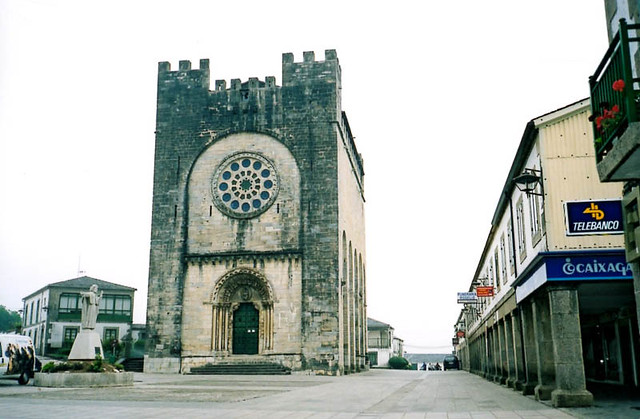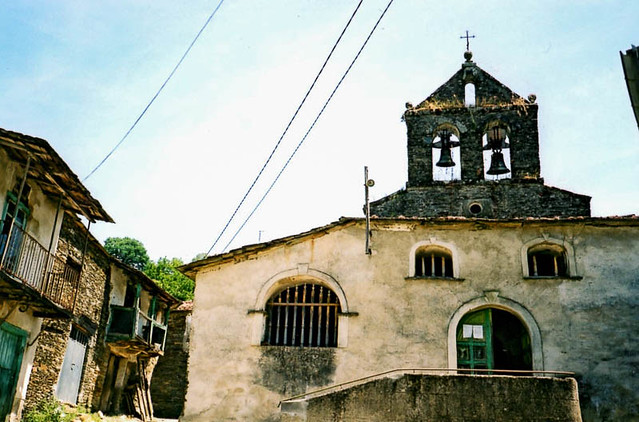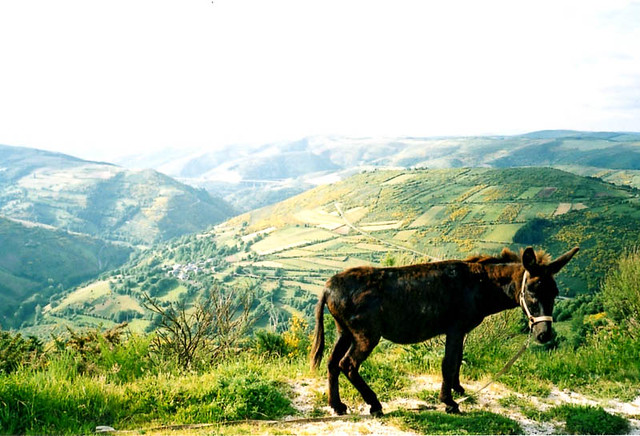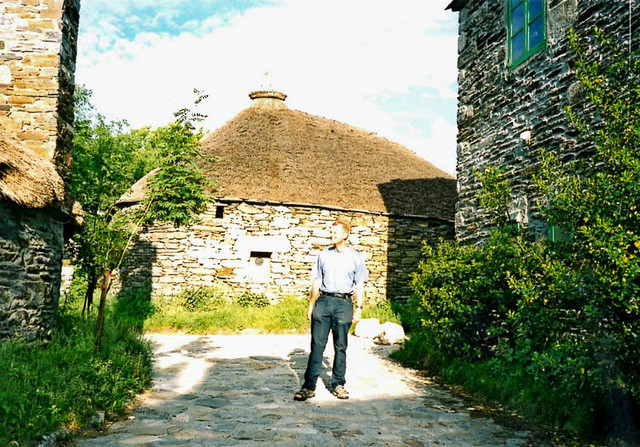free to be able to rate and comment on reports (as well as access 1:25000 mapping).
This is the continuation of the report from a long walk across Europe in 2003-4.
The first part of the report can be read on this link. The previous post can be read
here.Day 9Like the pilgrims, we too have now decided to wake before dawn to try to cover today’s distance before the afternoon heat strikes again. Not that we were asleep – we might have had the kitchen to ourselves, but the cows just outside the window moo loudly through the night, their deep bass seeming to shake the floor.
We set off down the road in the dark, reaching Portomarin in time to for first light and some breakfast. The deep valley here was flooded in the 1960s by a huge reservoir, and the whole village was moved up the hillside. The church, built in the twelfth century by the Knights Templar, a chivalric order that protected pilgrims on the camino, was moved from the valley floor stone by stone. It stands in the centre of the new village, square and fortified like a small castle keep– a refuge against bandits and Moors in this remote spot.

Across the dam, a stiff, misty climb up the far side of the valley led to a barer, upland region of tiny hamlets. The tightly clustered houses each have square, hipped roofs, tiled with gigantic slates, cut roughly into semi-circles. The topmost slates have slots cut into them, interlinking and overlapping with those on the other side – something I’ve never seen before. The fields are full of rough grasses and meadow flowers, and are enclosed by slabs of stone embedded edge-ways into the ground, broken only by the occasional hoary old oak.

The mist remains as we enter Sarria – the largest town since Santiago and hopefully a good place to recharge our batteries for a rest day. We head down the old, steep main street of crumbling houses and bars, where an old lady in a straw hat asks if we are looking for a room. One quick nod and we are whisked away down a tiny alleyway, up two flights of stairs and into a dusty attic. It’s full of odds and ends, cobwebs and discarded furniture. In a corner is an ancient bed, broken in the middle so badly that our heads and feet will be in the air whilst our backsides will almost touch the floor in a V-shape. We ask how much it is for two nights, and the lady counts her daily charge per pilgrim up and down on her fingers, but still fails to multiply seven by four without help. Later, I ask where we I can wash our clothes, and she leads me out into a tiny yard full of clucking hens, an old bath tub and a garden tap. She stays to watch for a few minutes before leaving me to it. By the time I’ve finished a chicken has escaped and has to be chased round in the lane until I finally shoo it back into the yard.
Later, lying in the ridiculously broken bed, I feel a lot less like a tourist.
Day 10There’s absolutely nothing to do here, which is good news for Helen’s ankle. Away from the old main street, the rest of the town is a grid-plan of typical Spanish blocks of concrete flats. But the fact is, I’ve never spent a more relaxing or enjoyable day in my life, sitting alternately in the sun or shade as time floats past. There’s a delicious feeling that we’ve earned this, that things are all on track – and that there’s no point in worrying about the days ahead.
Spanish eating hours are very late – four o’clock for lunch, nine at the earliest for dinner. This is completely unsuited to pilgrim life – we’ve learned that we need to keep getting up at dawn to beat the heat – so we decide we’ll start to make the lunchtime slot our evening meal. There are no visible restaurants here, but we catch a glimpse of a couple of tables in a room curtained off from a bar, and are shown through for the set meal. Caldo gallego (Galician cabbage broth), steak and chips, heaps of crusty bread, ice cream and a bottle of wine are all lingered over. When the bottle is empty the barman brings more – and the total cost is that of a couple of pints in our York local.
Day 11I’ve adapted to the ‘V’ shaped bed; I slept like a log in our attic last night. It certainly beats a noisy kitchen floor. A peaceful river valley and shady lanes bring us to Samos, the site of a great monastery.

This massive complex once housed five hundred Benedictine monks, but today only a handful remain. A monk in a black habit, a towering giant of a man, shows us round together with four other (real) pilgrims. He speaks Spanish very slowly and we manage to pick up some of the history of the place. There are two cloisters, one classical in style, the other gothic, both filled with abundant plants and trees. In the gallery above there are modern frescoes all the way round the walls depicting the life of St Benedict. It turns out that the monastery was all but destroyed in a great fire a hundred years ago, before being restored by the fascist dictator General Franco. His portrait at the reopening ceremony is still displayed – proudly? – on the walls.

The narrowing valley takes us through rich woodland until reaching San Cristabo do Real, a tiny, dilapidated village where the silence is oppressive. It looks like nothing has happened here for centuries, the dirt track road enclosed by crumbling, ancient wooden framed houses with projecting galleries upstairs.

Not all the houses are inhabited, and the place appears to be desperately poor to our eyes – is this really Western Europe? I didn’t know such places existed.

Beyond, the valley itself takes on a more rugged countenance, with rough and rocky hillsides beginning to enclose the pastoral views. We reach Triacastella in time for our late lunch, followed by a siesta in a smart private pilgrim hostel. Tomorrow we shall climb into the Sierra dos Ancares, the first mountains of our journey.
 Day 12
Day 12We set off at dawn so we can make the presumed tough ascent before the heat hits, but today there’s a wonderful cool breeze and the route turns out to be very gently graded. There are panoramic views, with pastoral farmland and woods behind us visible in miniature, whilst the rough scrubland around us rolls onwards up to the summits. The Sierra turn out to consist of vast, billowing hills rather than craggy mountains.

Once up high, the camino weaves around contouring the hillsides, and the ease of climb combined with the total change of scene means we walk along feeling euphoric. I could go on and on like this for ever – a feeling I’ve had on walks many times before – but this time, for once, I feel we’re really going to. As we arrive at the hostel at O Cebreiro, I’m suddenly brought back down to earth. I realise I’ve left my trekking pole behind a dispiriting three kilometres behind and have to walk back to collect it.
O Cebreiro is a remarkable village, but one which has been overtaken by tourism. At the same altitude as Ben Nevis, and with open panoramas all around, it nestles on a saddle off the main road.

Half of the buildings here are pallozas, Celtic houses built in a style dating from prehistoric times. Constructed in stone and oval in shape, the walls lean in and the pointed, thatched roofs look like sombreros. They are no longer lived in – most are now used as barns although one is a museum giving some idea of life inside. It was surprisingly spacious, with three rooms and furnished with box beds, though the tiny window holes admitted little light. The fire was on the floor in the centre, with no chimney, so the whole palloza must have been full of smoke when a home. Unfortunately this place has been smartened up so much that any authentic impression is lost.

A large ninth century church indicates that this has always been a key staging post for pilgrims. It’s incredible to think that this very church would have been visited by St Francis of Assisi on his own pilgrimage. The other buildings in the village include souvenir shops and restaurants catering to the many visitors, though I did sample the local cheese – fresh, soft and sweet, served with membrilla, a kind of quince jelly.
Continue to part 4